PG&E to pay more than $55 million to avoid criminal prosecution for starting two wildfires

- Share via
Pacific Gas & Electric Co. will avoid criminal charges for two wildfires started by its equipment under settlements announced Monday by district attorneys in six Northern California counties.
Prosecutors said the agreements were a better outcome for fire victims and communities, because limitations in criminal law make it difficult to hold corporations accountable. Some community advocates said the utility essentially bought its way out of culpability.
As part of the agreements, no criminal charges will be filed in connection with last year’s Dixie fire, and a criminal complaint regarding the 2019 Kincade fire will be dismissed. Together the fires burned more than 1 million acres in six counties, destroyed more than 1,700 buildings, injured nine firefighters and forced the evacuation of hundreds of thousands of residents.
The utility still faces charges in the 2020 Zogg fire, which killed four people and destroyed more than 200 buildings when it burned through 56,000 acres in Shasta and Tehama counties.
Under the settlements announced Monday, PG&E admits no wrongdoing. However, the utility has agreed to pay about $55 million over five years in civil penalties and payments to local nonprofits and educational organizations, and to reimburse Sonoma and Butte counties for the costs of investigating and prosecuting the cases. The costs may not be passed on to ratepayers. PG&E must also launch a program for victims of the Dixie fire through which those who lost their homes can submit claims for expedited review, approval and payment.
“Although criminal charges are dismissed, the level of punishment and oversight provided by this Judgment is greater than could be achieved against a corporation in criminal court,” Sonoma County Dist. Atty. Jill Ravitch said in a statement.
Had the Kincade fire trial been successful, the expected outcome was a fine of nearly $9.4 million, most of which would have gone to the state rather than Sonoma County, she said at a news conference. The maximum criminal fine in connection with the Dixie fire would have been just $329,417, according to the North State district attorneys, a consortium of prosecutors representing Butte, Lassen, Plumas, Shasta and Tehama counties.
“Criminal procedure provides for limited remedies against corporate offenders,” Ravitch said, adding that corporate defendants can’t be imprisoned and can be subjected only to fines or probation. She noted that after PG&E pleaded guilty to 84 counts of involuntary manslaughter for the 2018 Camp fire, it paid only $4 million.
“Is it perfect? Absolutely not. There will always be critics no matter what we do,” she said. “But I was not going to end up like [Dist. Atty.] Mike Ramsey up in Butte County listening to the CEO admit responsibility for 84 deaths and then simply paying a fine and walk away,” she said.
But community advocate Will Abrams, who lost his Sonoma County home in the 2017 Tubbs fire and is still awaiting payment through the PG&E bankruptcy proceeding that resulted from a string of Northern California fires, said the settlement is “equating dollars to justice and safety.”
Abrams, who evacuated his home during the Kincade fire, attended Monday’s court proceedings where the settlement was announced.
“While I was sitting in the courtroom, there was a line of criminals being prosecuted for individual felonies handcuffed and awaiting time with the judge,” he said. “They did not have the opportunity to financially negotiate away their felony charges. PG&E is given that opportunity time and time again.”
PG&E has also agreed to hire 160 to 200 employees in the six counties to bolster safety work, and enter into a five-year monitorship of its system inspection and vegetation management work in those counties.
That comes after the utility recently exited a five-year felony probation in connection with a 2010 natural gas pipeline explosion that killed eight people in San Bruno. During that time, PG&E set at least 31 wildfires that burned nearly 1.5 million acres and killed 113 Californians, according to U.S. District Judge William Alsup, who oversaw the probation. He urged state prosecutors to take additional oversight of the utility.
The monitoring will be overseen by a team of independent experts with Filsinger Energy Partners, which will ensure the utility complies with the wildfire mitigation safety plan it is required to file with the California Public Utilities Commission. The firm also serves as the independent safety monitor for the CPUC, whose oversight efforts were found to be lacking by a state auditor’s report released last month.
Some consumer advocates welcomed the development. “PG&E needs as many independent monitors as possible at this point,” said Mark Toney, executive director of the Utility Reform Network.
PG&E had faced five felony and 28 misdemeanor counts in the Kincade fire, including recklessly causing a fire that seriously injured six firefighters. Proceedings in the case had begun and included two days of testimony.
The fire began Oct. 23, 2019, under a PG&E transmission tower near the Geysers geothermal field in northern Sonoma County. It burned more than 77,000 acres, destroyed 374 buildings and seriously injured six firefighters over the course of 15 days, prompting the largest evacuation in the county’s history.
An investigation by the California Department of Forestry and Fire Protection identified the cause of the fire as a broken jumper cable that failed after years of wind-driven wear and arced against a steel transmission tower, sending sparks into dry vegetation below. The cable was attached to a transmission line that led nowhere — it had once been connected to a power plant that was mothballed in the early 2000s — but had not been de-energized, prosecutors said.
PG&E has separately agreed to pay $125 million in fines and penalties under a settlement reached with CPUC in connection with the fire.
Regulators have not yet assessed penalties in connection with the Dixie fire, which blazed a 1,500-square-mile path through five counties. The wildfire raged for more than three months last summer, burning an estimated 40% of Plumas County, including the Gold Rush-era town of Greenville, which was destroyed. It was the second-largest fire in California history and became the first to burn from one side of the Sierra Nevada to the other.
The fire started July 13 in Feather River Canyon when a Douglas fir fell onto an electrical distribution line, which Cal Fire investigators identified as the cause of the nearly 1-million-acre blaze. In federal court filings, PG&E described a series of mishaps and delays that resulted in an employee not reaching the site until about 10 hours later, by which time a 600- to 800-square-foot fire had ignited.
The utility has said its equipment might also be to blame for sparking the Fly fire, which started nine days later and eventually merged with the Dixie fire.
District attorneys in at least two counties — Butte and Plumas — had at one point been investigating PG&E for potential criminal liability in the fire.
Those prosecutors, together with the other North State district attorneys, elected to instead file a civil complaint accusing PG&E of unlawful business practices. The judgment resolving the case filed Monday allowed more flexibility in obtaining increased safety measures and rapid restitution to those who lost property, according to a news release from the consortium.
The settlement also requires that PG&E take additional safety steps in those counties, including implementing automatic power shutoffs when objects come into contact with high-risk distribution lines by the end of 2022 and undergrounding at least 400 miles of distribution lines by the end of 2024, the statement said.
“We are committed to doing our part, and we look forward to a long partnership with these communities to make it right and make it safe,” PG&E Chief Executive Patti Poppe said in a statement.
More to Read
Sign up for Essential California
The most important California stories and recommendations in your inbox every morning.
You may occasionally receive promotional content from the Los Angeles Times.











